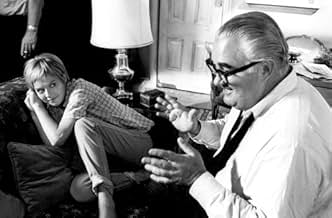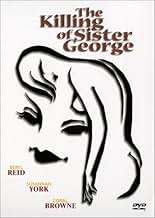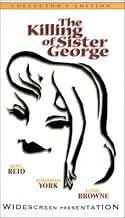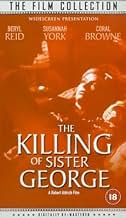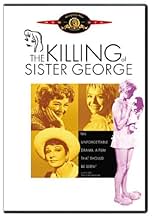IMDb-BEWERTUNG
7,0/10
2692
IHRE BEWERTUNG
Das Leben einer Seifenopernschauspielerin beginnt in dem Moment aus den Fugen zu geraten, als sie befürchtet, dass ihre Rolle aus der Serie gestrichen werden könnte.Das Leben einer Seifenopernschauspielerin beginnt in dem Moment aus den Fugen zu geraten, als sie befürchtet, dass ihre Rolle aus der Serie gestrichen werden könnte.Das Leben einer Seifenopernschauspielerin beginnt in dem Moment aus den Fugen zu geraten, als sie befürchtet, dass ihre Rolle aus der Serie gestrichen werden könnte.
- Regie
- Drehbuch
- Hauptbesetzung
- Auszeichnungen
- 1 Nominierung insgesamt
Empfohlene Bewertungen
I don't give many movies 10/10, but this black comedy-drama gets my vote, for fine acting, production values, and of course its place in movie history in the frank portrayal of lesbian relationships.
Others have & will comment on the latter, so I'll point out some of the other aspects of this fine film. The combination of comedy with personal tragedy poses difficult problems both for the writer & director; here they both succeed brilliantly.
The three principals' performances are riveting. I particularly liked the ambiguity of Coral Brown's portrayal of Mercy Croft; watch her carefully in the tight closeups in the gay club, and notice how the down-turned mouth at times hides a hint of a self-satisfied smile.
The cinematography deserves special mention. The use of colour is beautiful; I was reminded of "The Umbrellas of Cherbourg", but it never steps over the line into unreality. On the contrary, the alleys of London, the TV studio and above all the stairs and corridor of the flat are supremely realistic. Most unusual is the use of chiaroscuro, the interplay of light-and-shadow, seldom seen outside of black & white films. In so many colour films the light appears to come from some amorphous omnidirectional source out of science fiction; great for lighting everything and everybody evenly, but unrealistic and DULL. Look at the shadows as Beryl Reid ('George') enters the apartment building and climbs the stairs, or in some of the bedroom scenes. Apart from its other many virtues, this movie held my attention as a fine piece of film-making.
All in all, a masterpiece; my one regret is that it was shown on TV in pan-and-scan. It IS now available in DVD - in several formats & regions - so I look forward to watching it again in its original form.
Others have & will comment on the latter, so I'll point out some of the other aspects of this fine film. The combination of comedy with personal tragedy poses difficult problems both for the writer & director; here they both succeed brilliantly.
The three principals' performances are riveting. I particularly liked the ambiguity of Coral Brown's portrayal of Mercy Croft; watch her carefully in the tight closeups in the gay club, and notice how the down-turned mouth at times hides a hint of a self-satisfied smile.
The cinematography deserves special mention. The use of colour is beautiful; I was reminded of "The Umbrellas of Cherbourg", but it never steps over the line into unreality. On the contrary, the alleys of London, the TV studio and above all the stairs and corridor of the flat are supremely realistic. Most unusual is the use of chiaroscuro, the interplay of light-and-shadow, seldom seen outside of black & white films. In so many colour films the light appears to come from some amorphous omnidirectional source out of science fiction; great for lighting everything and everybody evenly, but unrealistic and DULL. Look at the shadows as Beryl Reid ('George') enters the apartment building and climbs the stairs, or in some of the bedroom scenes. Apart from its other many virtues, this movie held my attention as a fine piece of film-making.
All in all, a masterpiece; my one regret is that it was shown on TV in pan-and-scan. It IS now available in DVD - in several formats & regions - so I look forward to watching it again in its original form.
While there is delicate humor here, as in the movie's satire on the twee reassurances and stereotyping of an English soap opera's portrayal of homely English village life, this movie is in the end an unsettling portrait of the human condition, of the ugliness, the uncontrollable and incendiary nature of our sexual and emotional longings and need.
I spent years wanting to see this movie, if only because of its legendary nature and Coral Browne's presence in the cast, and it's nothing like what I imagined. Given the title and all the talk in books about scenes set in a dark and intense demimondaine world of lesbian bars, I pictured some sort of police procedural about lesbians being killed by a serial killer, a Sidney Sheldon-type story.
Ostensibly a portrait of an aging actress's dying career, the heart of the picture is the competition among the characters for love, for the ruthless quest for success and the money and companionship that go with it.
There is constant sado-masochistic emotional gamesmanship here, with characters playing roles that are alternately passive and active. One character pretends to be not much more than a slip of a girl and sits by and watches as others compete for her attentions.
The sex scene in the movie, while ugly in the extreme, is vital to the film's message. (I'm amazed that this aired, even late at night, on Turner Classic Movies, so that I, thankfully, got a chance to see the movie.) Coral Browne's face, stripped of its mask of demure self-possession, exposing the animal (the monster?) that we all are at the core of our being--that's something to see. And unsettling.
I'll never particularly care for Susannah York. She'll always strike me as a bit of an over-praised, over-successful relic of the 1960s, a kind of prissy relic, but what a film, even with some longeurs. And the towering--both literally and figuratively--Coral Browne: what a presence.
I spent years wanting to see this movie, if only because of its legendary nature and Coral Browne's presence in the cast, and it's nothing like what I imagined. Given the title and all the talk in books about scenes set in a dark and intense demimondaine world of lesbian bars, I pictured some sort of police procedural about lesbians being killed by a serial killer, a Sidney Sheldon-type story.
Ostensibly a portrait of an aging actress's dying career, the heart of the picture is the competition among the characters for love, for the ruthless quest for success and the money and companionship that go with it.
There is constant sado-masochistic emotional gamesmanship here, with characters playing roles that are alternately passive and active. One character pretends to be not much more than a slip of a girl and sits by and watches as others compete for her attentions.
The sex scene in the movie, while ugly in the extreme, is vital to the film's message. (I'm amazed that this aired, even late at night, on Turner Classic Movies, so that I, thankfully, got a chance to see the movie.) Coral Browne's face, stripped of its mask of demure self-possession, exposing the animal (the monster?) that we all are at the core of our being--that's something to see. And unsettling.
I'll never particularly care for Susannah York. She'll always strike me as a bit of an over-praised, over-successful relic of the 1960s, a kind of prissy relic, but what a film, even with some longeurs. And the towering--both literally and figuratively--Coral Browne: what a presence.
Robert Aldrich is a director who rarely gets the attention he deserves. Ridiculously versatile he made the fascinating Film Noir 'Kiss Me Deadly', the gothic black comedy 'Whatever Happened To Baby Jane?', and the macho "tough guys on a mission" action classic 'The Dirty Dozen' to name just three in a long career. Just to emphasize that he could do just about anything, one of the first movies he made after 'The Dirty Dozen' was 'The Killing Of Sister George'. It's hard to imagine two more different movies! George is a very English picture about a much loved soap opera star (played by Beryl Reid) who has to juggle a career crisis with a complex lesbian relationship (her lover being played by Susanna York). Reid was well known to British audiences through her TV work, especially a couple of highly popular John Le Carre adaptations. Reid originated the Sister George role on the stage and she really makes the most of it in this movie. Her performance is terrific, hilariously bitchy and also very sad and pathetic. York is also good, and the lesbian subject matter must have been very shocking for the time. It may look a little dated now, but in context it is quite sensitively handled. There are some great actors in the supporting cast, most notably Coral Browne ('Theatre Of Blood') who plays a TV producer who has her eye on York. 'The Killing Of Sister George' deserves a bigger audience. I highly recommend it and hope that anyone who enjoys it looks further into the career of the Robert Aldrich, a seriously underrated film maker!
this is a showcase for some magnificent acting....it doesn't seem at all homophobic , but rather immensely poignant and sad...and in what other film do you get to see a great lesbian band in matching sweaters and guitars (good solo!) Difficult at the beginning, just seems shallow and bitchy, but stick with it and watch Beryl Reid's character disintegrate....the final scene reminded me of "The Blue Angel" or "The Entertainer" in its shattering degradation...congrats to Aldrich for having the guts to make this movie, I think it stands the test of time rather well. Coral Browne is also magnificent, and York holds her own. The lesbian bar scene is worth waiting for.
Am I the only one who finds it painfully touching that Robert Aldrich went from the biggest hit of his career--the almost woman-free DIRTY DOZEN--to the kind of movie he really wanted to make, i.e., a stagebound melodrama about an aging lesbian soap star's love for a demented nymphet? In its day, SISTER GEORGE was considered the ne plus ultra in coarse homophobia; critics saw the sweaty thumbprints of the Aldrich Touch on every girl-on-girl scene. (Does anyone now lambaste THE BITTER TEARS OF PETRA VON KANT for not being hardhitting docudrama?) In retrospect, the movie seems to me one of Aldrich's most affecting, with Coral Browne (December) and a teeny, teenaged Susannah York (May) grand-slamming this folie a deux to a fare-thee-well.
Wusstest du schon
- WissenswertesThe lesbian lovemaking scene so disgusted Robert Aldrich's longtime composer friend Frank De Vol that he quit the production and didn't work with Aldrich for several years.
- PatzerWhen George asks for a pint of beer the waiter arrives with it on a tray and it is half full with half a glass of head but when he puts it on the table it's much fuller, with only about an inch of head on it.
- Crazy CreditsDuring the opening credits, the picture distractingly flips from left to right as the main character travels through claustrophobia-inducing alleyways.
- VerbindungenFeatured in Before Stonewall (1984)
Top-Auswahl
Melde dich zum Bewerten an und greife auf die Watchlist für personalisierte Empfehlungen zu.
- How long is The Killing of Sister George?Powered by Alexa
Details
- Erscheinungsdatum
- Herkunftsland
- Sprache
- Auch bekannt als
- The Killing of Sister George
- Drehorte
- Produktionsfirmen
- Weitere beteiligte Unternehmen bei IMDbPro anzeigen
- Laufzeit2 Stunden 18 Minuten
- Sound-Mix
- Seitenverhältnis
- 1.85 : 1
Zu dieser Seite beitragen
Bearbeitung vorschlagen oder fehlenden Inhalt hinzufügen

Oberste Lücke
By what name was Das Doppelleben der Sister George (1968) officially released in India in English?
Antwort

